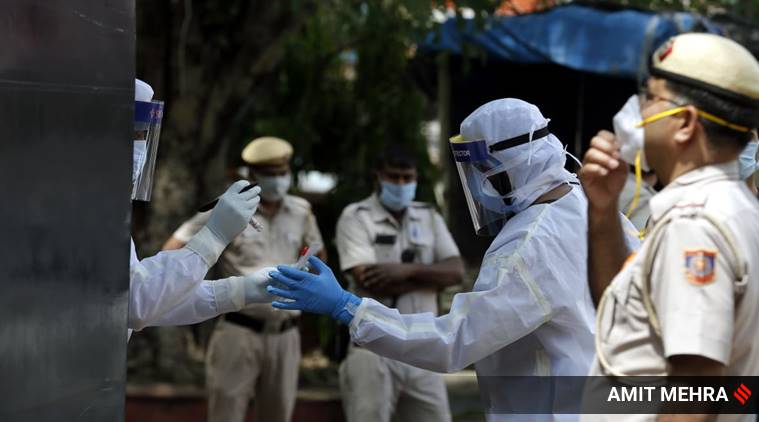Explained: Where does COVID-19 virus first strike? Study pinpoints two cell types in nose
LAST WEEK, scientists reported that they have identified two specific types of cells in the nose as the likely initial infection points for SARS-CoV2, the novel coronavirus that causes COVID-19 (briefly reported in The Indian Express, April 25). A look at how this adds to the emerging knowledge about the new virus:
Was the mechanism of infection not already known?
Yes, previous studies have shown what happens at the cellular level. The entry of the virus takes place by means of a “lock and key” effect. Like all coronaviruses, SARS-CoV2 consists of a fatty envelope with a “spike protein” on the surface. The spike acts as the “key” to “unlock” a protein on the human cell, called ACE2, which acts as the receptor for the virus. Once inside the cell, the virus uses a second protein, called TMPRSS2, to complete its entry. TMPRSS2 has protein-splitting abilities, which allow the virus to reproduce and transmit itself inside the cell.
So, what has the new study found?
The new study has identified the specific cells where the mechanism of entry most likely comes into play when the virus begins it attack. These are the goblet and ciliated cells in the nose, researchers from the Wellcome Sanger Institute (UK), University Medical Centre Groningen, University Côte d’Azur and CNRS, Nice and their collaborators have reported in the journal Nature Medicine.
Goblet cells are mucus-producing cells on the surface of organs, and are found along the respiratory tract, along the intestinal tract, in the upper eyelid etc. Ciliated cells are hair-like cells, again occurring on the surface of various organs, and help sweep mucus, dust etc to the throat, where it can be swallowed.
How did the study identify these cells as the likely points of initial infection?
The researchers looked for areas where the two key proteins, ACE2 and TMPRSS2, express themselves most prominently. For this, they turned to the Human Cell Atlas, an international consortium that aims to create comprehensive reference maps of all human cells. They looked at multiple datasets from more than 20 different tissues of non-infected people. These included cells from the lung, nasal cavity, eye, gut, heart, kidney and liver.
And what did the data show?
Both proteins were found in multiple organs. However, ACE2 expression was generally low while TMPRSS2 was highly expressed with a broader distribution. This suggests that ACE2, rather than TMPRSS2, may be a limiting factor for viral entry at the initial infection stage, the researchers wrote in the paper.
“We found that… ACE2 and TMPRSS2… are expressed in cells in different organs, including the cells on the inner lining of the nose. We then revealed that mucus-producing goblet cells and ciliated cells in the nose had the highest levels of both these COVID-19 virus proteins, of all cells in the airways. This makes these cells the most likely initial infection route for the virus,” first author Dr Waradon Sungnak, from Wellcome Sanger Institute, said in a statement issued by the institute.
Does this rule out other entry points?
The two entry proteins were also found in cells in the cornea of the eye and in the lining of the intestine. The researchers said this suggests another possible route of infection via the eye and tear ducts, and possible oral-faecal transmission. However, they note that:
* The two cell types in the nose, where the proteins were expressed at the highest levels, are located at a place that is highly accessible for the virus.
* The study also found that ACE2 production in the nose cells is probably switched on at the same time as various immune genes that would be activated when the cells are fighting the infection.
* The virus is thought to be spread through respiratory droplets produced when an infected person coughs or sneezes.
 The virus is thought to be spread through respiratory droplets produced when an infected person coughs or sneezes. (Express photo/Amit Mehra)
The virus is thought to be spread through respiratory droplets produced when an infected person coughs or sneezes. (Express photo/Amit Mehra)
How does the knowledge help?
This is the first time that these two cell types have been pinpointed as the likely points of initial entry. The researchers believe their identification could help explain the high transmission rate of COVID-19.
“This information can be used to better understand how coronavirus spreads. Knowing which exact cell types are important for virus transmission also provides a basis for developing potential treatments to reduce the spread of the virus,” said Dr Sarah Teichmann, senior author from Wellcome Sanger Institute and co-chair of the Organising Committee of the Human Cell Atlas.




